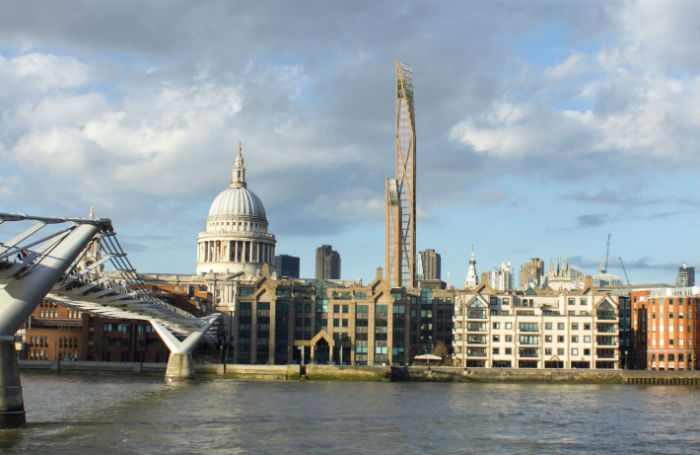A reworked submission process and new categories has enabled more research entries from practice, and of higher quality, to reach the top of the RIBA President's awards for Research.
The highest rated practice entry and winner of the new Design and Technical category in the RIBA Research Awards, Supertall Timber: Design Research for the Next Generation of Natural Structure, was a joint effort between PLP Architecture, engineers Smith and Wallwork, and Cambridge University School of Architecture,.
The project is an inspiring case study of interdisciplinary research, bringing together practice and academia that through a combination of theoretical design and physical testing demonstrate the viability of timber buildings at much greater heights than was previously thought possible.
At present, the world's tallest timber building is a 14-storey apartment block in Bergen, Norway. The winning Supertall 'Oakwood Tower' proposal presents a timber tower nearly 300m high, integrated into London's Barbican, which would make it the second tallest building in London after The Shard. The tower would contain over 1000 apartments.

PLP partner Kevin Flanagan says it has been a study of how timber, specifically cross-laminated timber, can withstand different structural forces. 'It's been wonderful to see a whole new design language for the material realised,' he says.
The proposal was located among familiar London landmarks on purpose to test reactions. Flanagan reports that 'so far it has been overwhelmingly positive, with the design featured already in thirty periodicals and in news reports on the BBC, CNN and almost every major international news outlet'.
With the structural design proven, the project is continuing as a feasibility study focussing on assembly.
Of the 74 other submissions to the Research Awards received from 14 countries, 22 were from practices or practice collaborations, up from just four the previous year.
After a thorough review of the awards framework earlier this year, the previous four categories that included just one for practice-based research were replaced by four thematic categories instead.
'With all submissions anonymised, it made it almost impossible for the judges to identify which papers came from which source and made for some surprises after judging was complete,' says Dr Kat Martindale, RIBA Head of Research and Innovation.
'The scope and scale of collaborations between practice and academia was a revelation.'
One of the two commended entries in this year's President's Awards papers was from Richard Coutts and Robert Barker of Baca Architects. Their submission documented not only their extensive research into designing for flood risk, but presented their design for the UK's first floating house, the Can-float Amphibious Building, built as a replacement house on Lock Island, a small island located on the River Thames in south Buckinghamshire.
The house sits within a dock structure. In a flooding event, the dock fills incrementally as the water level rises. When the groundwater/river level is just below ground level, the house becomes buoyant and can rise up to 2.7m to cope with a 1-in-100-year flood event.
The judges felt this paper will act as a model for other practitioners with expert knowledge in their own particular field. Barker and Coutts's paper can demonstrate to others who have not had the opportunity or indeed the confidence to formalise their work, how a systematic and methodical account of the development of their expertise can lead to publicity and reward.
With such a strong research showing from practices this year, Martindale says it is something the RIBA hopes to build on next year.
Applications for the 2017 President's Awards for Research will be invited from 1 May to 31 May 2017 for the categories History and Theory, City and Community, Design and Technical, and the next year's annual theme of Housing. Further details will be available from January.
The RIBA President's Awards for Research winning projects, to be featured in a special issue of The Journal of Architecture:
WINNER OF THE 2016 PRESIDENT'S MEDAL FOR RESEARCH AND WINNER OF THE CATEGORY 'HISTORY AND THEORY'
Asmara - Africa's Modernist City: UNESCO World Heritage Nomination.
Edward Denison, The Bartlett School of Architecture, UK
Medhanie Teklemariam and Dawit Abraha, Asmara Heritage Project, Eritrea
WINNER OF THE ANNUAL THEME - 'LEARNING FROM PROJECTS' AND HIGHLY COMMENDED
Make Public: Performing Public Housing in Ernö Goldfinger's Balfron Tower.
David Roberts, Bartlett School of Architecture, UK
WINNER OF THE CATEGORY 'CITIES AND COMMUNITY'
The Common Camp: Temporary Settlements as a Spatio-political Instrument in Israel-Palestine.
Dr Irit Katz, University of Cambridge, UK
WINNER OF THE CATEGORY 'DESIGN AND TECHNICAL'
Supertall Timber: Design Research for the Next Generation of Natural Structure.
Dr Michael Ramage and Dr Rob Foster, University of Cambridge, UK
Simon Smith, Smith and Wallwork, UK
Kevin Flanagan & Ron Bakker, PLP / Architecture, UK
COMMENDED
Palestine Regeneration Team (PART).
Dr Yara Sharif, Golzari NG Architects and PART, UK;
Dr Nasser Golzari, Golzari-NG Architects, PART / University of Westminster, UK; Prof Murray Fraser, Bartlett School of Architecture and PART, UK
COMMENDED
UK's First Amphibious House. Can-float Amphibious Building.
Richard Coutts & Robert Barker, Baca Architects, UK
Text by Neal Morris, © RIBA.









